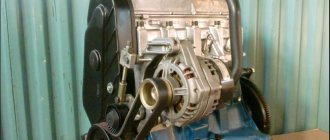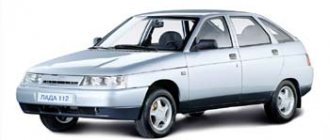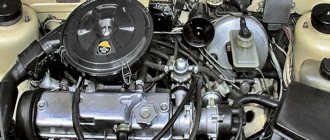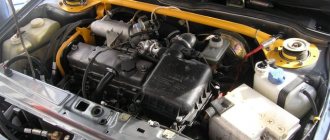Download .xls file
xls
Download picture
Send by email
| PARAMETER | MEANING |
| Number of cylinders | 4 |
| Volume, l | 1.596 |
| Piston stroke, mm | 75.6 |
| Compression ratio | 11 |
| Number of valves per cylinder | 4 |
| Cylinder block material | Ductile iron |
| Supply system | injector |
| Gas distribution system | DOHC |
| Cylinder operating order | 1-3-4-2 |
| Rated motor power | 78 kW (106.0 hp)/ 5800 rpm |
| Maximum torque | 148 Nm / 4000 rpm |
| Supply system | Electronically controlled distributed injection |
| Min octane number of gasoline used | 95 |
| Recommended Engine Oil | Synthetic |
| 5W-30 | |
| 5W-40 | |
| 10W-30 | |
| 10W-40 | |
| 15W-40 | |
| Oil volume in the lubrication system | 3.5 l |
| Oil quantity when changing | 3-3.2 l |
| Engine weight included, kg | 116 |
| Oil change carried out, km | 10000 |
The motor is installed on LADA Priora, Lada Kalina 2 and Lada Granta.
Technical characteristics of the VAZ 21127 1.6 16kl engine
| Type | in-line |
| Number of cylinders | 4 |
| Number of valves | 16 |
| Exact volume | 1596 cm³ |
| Cylinder diameter | 82 mm |
| Piston stroke | 75.6 mm |
| Supply system | injector |
| Power | 106 hp |
| Torque | 148 Nm |
| Compression ratio | 10.5 — 11 |
| Fuel type | AI-92 |
| Environmental standards | EURO 4 |
Are the valves bending?
Since the 21127 motor is built on the basis of the 21126 unit, the situation with valve bending is the same. The problem arose during the use of lightweight pistons without deep recesses on the bottoms. As a result of a broken timing belt, the camshaft stops, but the crankshaft continues to rotate by inertia, pushing the pistons up. The valve stems are bent due to a collision with the pistons, and parts can only be replaced during a major overhaul.
Knowing about the shortcoming of engine 21127, the plant initially made recommendations on maintenance regulations. Despite the declared timing belt resource of 200,000 km and an automatic tensioner, it is necessary to check the integrity of the drive and the quality of tension every maintenance. The belt can fall off not only due to natural wear, but also as a result of jamming of the idler roller or pump. In practice, the belt has to be changed after 50 - 60,000 km to prevent damage to the valve legs.
Since the fall of 2022, the question “whether the engine valves are bent” has been removed. Federal Mogul has released new non-button pistons with full valve stroke recesses. Now owners of cars with critical engines can change the piston group and forget about the problem of a broken belt.
Design features of the Lada 21127 16 valve engine
The donor for the new power unit was the already well-known VAZ 21126 engine. The main difference from its predecessor is the use of a modern intake system with flaps. Let us briefly describe the principle of its operation. Air enters the cylinders in different ways: at high speeds it is directed along a long path, and at low speeds it is directed through a resonance chamber. Thus, the completeness of fuel combustion increases: i.e. power increases - consumption decreases.
Another difference is the abandonment of the mass air flow sensor in favor of DBP+DTV. Installing a combination of absolute pressure and air temperature sensors instead of the mass air flow sensor saved owners from the common problem of floating idle speed.
Otherwise, this is a typical VAZ injection 16-valve unit, which is based on a cast iron cylinder block. As on most modern Togliatti models, there is a lightweight Federal Mogul ShPG, and the Gates timing belt is equipped with an automatic tensioner.
Malfunctions
Despite various upgrades, the engine in the VAZ 21127 retained all the faults of its predecessor, the main ones of which are shown in the table:
| FAULT | CAUSE |
| The engine starts to stall | Coking of injectors. |
| Malfunction of ignition coils. | |
| Reduced compression. | |
| Cooling system overheating | Thermostat malfunction. |
| Formation of a mud coat as a result of oil leakage. | |
| Knocks and noises at the top of the engine | Malfunctions of hydraulic valve compensators |
| Knocks at the bottom of the engine | Main bearing wear |
| Knocks in the middle of the engine | Connecting rod bearings and piston pin faults |
| Bend cylinder head valves | Belt drive slipping through gear tooth |
| Interruptions and startup problems | Violations in the operation of the timing belt. |
| Malfunctions in the fuel pressure system. | |
| Air leak. | |
| Broken throttle valve. | |
| Sensor malfunction. | |
| Power reduction | Burnt out timing head gasket. |
| Burnout of pistons, wear of rings and cylinders. |
Specifications
power 21129 (127) – 106 hp. (21126 – 98hp)
Torque 21129 (127) – 150 N.m (21126 – 145 N.m.) at 4000 rpm.
Mixed fuel consumption is 7-10 liters per 100 km. More details about fuel consumption
Recommended fuel – AI 95
Motor weight – 115 kg.
The table above shows the torque and power graph of the 1.6L 21129 engine and its comparison with the 21179 1.8L engine.
Which cars are equipped with ICE 21127?
Immediately after development, engine 21127 is recommended to be installed on cars manufactured by AvtoVAZ:
- Lada Granta - since 2013, Lux and Norma configurations;
- Lada Kalina-2 - since 2013, only with a manual transmission, mainly on sedans and hatchbacks;
- Lada Priora - since 2013, Luxury equipment.
Lada Priora Luxe configuration
In principle, the engine’s sufficiently high performance characteristics made it possible to install it on the Lada Largus, Vesta and X-Ray. However, by the time of their serial production, the ICE 21127 had been upgraded to the next version 21129 with a control unit that complies with Euro-5 standards, so the plant management limited itself to the indicated modifications, leaving the volumes the same.
Motor 21129
Oil
The oil used in this engine is similar to 21126: synthetic, semi-synthetic
5W-30 5W-40 10W-40 15W40
Oil sump volume
This point will be useful for those who are going to change the engine oil. With different transmissions, the volume of oil poured into the engine is also different.
VAZ 21129 + Renault manual transmission (cast crankcase) = 4.4l
VAZ 21129 + robot (stamped crater) = 3.2 l
The engine resource is 200 km. But in practice, you need to monitor the condition of the roller, pump and timing belt, because if individual valve elements jam, they will meet the piston group, and then both will come to an end. In addition, during the impact of these elements, it is not uncommon that the crankshaft bends slightly. You can drive with such a crankshaft, but there will be huge oil consumption.
Maintenance
In order to carry out major overhauls as rarely as possible, it is recommended to service engine 21127 according to the regulations:
- The timing belt drives the timing pulleys for 20–50 thousand km, but it needs to be inspected three times more often;
- The oxygen sensor has a slightly shorter service life - 10 thousand hours;
- The cooling system and the antifreeze itself, filters and fuel tank cap can withstand 40 thousand km of operation;
- the threshold of 25 thousand mileage cannot be overcome by spark plugs, belts and attachment belts;
- The filter along with the oil is changed every 10 thousand km.
To save budget, the internal combustion engine device allows you to perform all the specified maintenance operations in the garage without visiting service stations.
Features of 21129 engine/differences
The main feature of the 129 engine is the “innovative” for AvtoVAZ installation of an intake receiver with variable chamber geometry and volume. Due to the damper, the volume of the intake chamber changes depending on the speed. As practice shows, the damper is activated at 3500 engine speeds.
In addition, the engineers managed to get rid of the mass air flow sensor - mass air flow sensor. Along with him, his ailments went away, which tormented the owner of the 21126 engine: unstable idling, sometimes exorbitant consumption, high cost. Instead of mass air flow sensors, engineers installed a connection from DBP and DTV sensors (atmospheric pressure and air temperature sensors). This is where the differences from the 126 engine end. Speaking in fact, the intake system with variable geometry is as old as the world and has been installed by global manufacturers almost since the 80s.
Differences 21129 from 21126 (mounted layout, transition from mass air flow sensor to DBP+DTV, presence of an intake receiver with variable geometry.
Differences between 21129 and 21127 (Different layout, different firmware)
Typical breakdowns, causes, elimination
Since the 21127 motor uses a lightweight ShPG, as a result of a sudden belt break, the piston is 100% guaranteed to bend the valve. In addition, there are “diseases” characteristic of this motor:
| Power reduction | 1) burnt out valves 2) clogged air filter 3)fuel system malfunction 4) clutch slipping 5) wear of camshaft cams | 1)replacement of valves 2) cleaning or replacing consumables 3) cleaning and repair 4) clutch replacement 5) installation of a new camshaft |
| The internal combustion engine runs after the ignition is turned off | 1) carbon deposits inside the combustion chambers and on the valves 2) Problems with the ignition switch | 1)washing with a cleaning agent 2)replacing the ignition switch |
| Emergency pressure lamp comes on | 1) wear of the oil pump or main bearings 2) short circuit 3)low oil level | 1) replacement of parts 2) electrical repair 3) adding lubricant to the level |
In principle, no special complaints were noticed with the ICE 21127; this power drive is considered reliable and economical to operate.
Engine tuning 21129
Tuning the 21129 engine is no different from the 126 engine.
Easy tuning : Euro-2 or Euro-2 firmware + installation of 4-2-1 exhaust
Medium tuning : Exhaust 4-2-1 + Shafts + firmware (preferably flashed online)
Deep : includes modification of the head, replacement of valves, pushers, etc. All technical characteristics of Vesta.
Guys, with which engine is it better to take 126 or 127 (106 hp)? About the Priora 1.8 with an engine of 128 (124 hp) the reviews are bad, that they bring it to the service in tow, the timing roller gets stuck.. In general, let's discuss which engine with is it better to take?)
Service
The power unit must undergo periodic maintenance every 10 thousand kilometers. Under severe operating conditions, oil and filter changes should be carried out every 7.5 thousand.
When replacing the oil filter, you should pay attention to oil leakage through the valve cover seals. This malfunction is due to the poor quality of the sealing gasket, which leads to contamination of the cooling surfaces and overheating of the motor.
A special feature of the maintenance of this engine is the periodic replacement of hydraulic valve compensators.
When operating a car with this engine, its temperature should be controlled - 95-98 degrees Celsius, otherwise the elements of the cooling system will wear out very quickly. The cause of this is usually the thermostat, which is the weak element in this system.
Removal of the exhaust pipe should be carried out with extreme caution; instead of copper nuts, the manufacturer installed steel ones; if they sour, the mounting brackets can break off. When carrying out this type of work, it is better to immediately replace these nuts with copper ones.
The worst feature of this engine is that when it fails, the engine bends the timing valve, leading to expensive repairs. Tensioning and replacing the timing belt is best done at a service center. The Lada Priora engine has 106 hp. p., according to reviews from owners, high-quality oil should be poured, otherwise the hydraulic valve compensators will fail very quickly.
The engine is also marked by knocking in the elements of the crank mechanism, main and connecting rod bearings, while the engine shakes.
Pros and cons of the motor
The main feature of the ICE 21127 remains the insufficient safety of the valves, which can be bent by the pistons if the timing belt breaks. The second disadvantage is the expensive overhaul, even if you do it yourself:
- the timing belt complete with automatic tensioner and pulley is expensive, as it is produced by the foreign company Gates;
- The ShPG kit also has a high price, since it is manufactured by another foreign manufacturer, Federal Mogul.
The advantages of the design are:
- attachments are conveniently located, which reduces labor costs for maintenance and repairs;
- increased torque and power of the internal combustion engine.
On the one hand, the manufacturer AvtoVAZ has expanded its line of engines with version 21127. On the other hand, it has provided a new spare part - an improved receiver with an inertial charging system, which is a definite plus:
- owners of Grant, Prior and Kalin of the second generation, equipped with 21126 engines, can buy this unit;
- install it yourself instead of the standard receiver of the previous configuration;
- remove the mass air flow sensor, install DBP and DTV sensors to get a power of 106 hp. With. instead of the factory 98 hp. With.
There are no other changes in the design of the internal combustion engine; there is no need to re-register the car with the traffic police. Transport tax and insurance will be cheaper, since the plant’s vehicle certificate indicates less power.
How much does engine 126 and 127 cost?
Engine 126 has catalog number 21126100026030, sells for about 107,000 rubles, engine 127, respectively, has catalog number 21127100026030, its price is slightly higher by 3-5 thousand rubles. The price on the secondary market will be significantly lower (up to 20-25 thousand rubles), but the savings will not pay off - a used “engine” can last no more than 1000 km, this is a real lottery.
How to find out what engine is in a Priora
You can find out by looking at the plate on the left glass of the rack, where the engine number is written on the edge. From it you can understand the 8-valve unit, or 16. You can also recognize the modification 21126 or 21127.
Video on changing oil in a VAZ engine
As a reminder, use only the engine oil recommended by the manufacturer. And also do not forget to change the oil in the Lada gearbox on time.
Keywords: lubrication system for Lada Granta | lubrication system for Lada Priora | lubrication system for Lada Kalina | Lada Granta filters | filters for Lada Priora | filters Lada Kalina | Lada Priora engine | Lada Kalina engine | Lada Granta engine | lubrication system for Lada Vesta | Lada Vesta filters | Lada Vesta engine | lubrication system for Lada Largus | 4x4 lubrication system | Lada Xray lubrication system | filters Lada Largus | filters 4x4 | lada xray filters | Lada Largus engine | 4x4 engine | lada xray engine | Niva lubrication system | Niva engine | Niva filters | universal article
0 0 0 0 0 0
Share on social networks:
Reliability, weaknesses, maintainability
Reliability
The reliability of the engine is eloquently evidenced by the fact that the resource declared by the manufacturer is almost doubled. According to reports from car owners, there are engines with mileage of more than 350 thousand km without any significant repairs.
All car enthusiasts unanimously claim that with timely and high-quality maintenance, the VAZ-21129 is reliable and economical. You can read about this many times in the reviews of participants in various specialized forums.
For example, VADIM writes: “...1.6 engine mileage 83,500 km. Fuel consumption: city 6.5 - 7.0, highway 5.5 -6.0. Depends on the speed, quality of gasoline, and also on the build quality of the engine itself. There is no oil consumption, no topping up from replacement to replacement.”
Roman has the same opinion. He reports: “... I drive a Largus Cross 5 seats, I bought it at the dealership in June 2022, the mileage is 40 thousand km, the oil in the Lada Ultra engine is 5w40, I try to change it every 7000, during this time I don’t notice waste, oil consumption, from outsiders noise - the hydraulic compensators are knocking, and even then, in the first three or four seconds after starting in frost of -20, I don’t consider this critical, the engine is familiar from the Priora, it loves speed and does not consume much fuel.” Alexey adds: “...an excellent engine, it pulls well from low to low on the highway, low consumption of 5.7 liters!”
Well, those car owners who ignore timely maintenance, skimp on technical fluids, and really abuse the engine, can only sympathize.
As an example, the bewilderment of Soar Angele: “...Vesta 2022 mileage 135t km engine 21129 chip tuning done, forward flow on 51 pipes, tires R16/205/50 holder. There was a consumption of 10 liters in urban style, then suddenly the consumption increased to 15 liters per 100...”
Or like this. Razrtshitele from Vologda wrote the following opus: “... about engine speeds: the problem is that when the car is rolling at a speed of 5 km/h, it is difficult to get into 1st gear, but it’s easy to get into second gear. You stick it in, try to drive and drive with tension...”
For what??? Why stick into first gear if the car is already moving? To check the reliability of the engine and transmission? Comments, as they say, are unnecessary.
Issues of internal combustion engine reliability are constantly in the field of view of the manufacturer. Thus, in August 2022, the piston group was modified. The result was the elimination of the phenomenon of bending of valves when they come into contact with the piston.
Conclusion: The VAZ-21129 is a completely reliable engine if treated appropriately.
Weak spots
They are available on the VAZ-21129, but it must immediately be emphasized that they are not critical.
Complaints about the operation of the cooling system are caused by a poor-quality thermostat.
The main culprit for overheating is the thermostat.
There is some truth in this. It happens that the thermostat stops working, which can cause the engine to overheat. Or vice versa, it takes too long to warm it up to operating temperature. Both are bad.
In the first case, there is almost a 100% prerequisite for a major overhaul; in the second, prolonged but increased wear of the rubbing surfaces of the CPG will lead to the same result. There is only one way to solve the problem - to detect the malfunction in time and immediately take measures to eliminate it.
Timing drive. The operating life of the drive belt is set by the manufacturer at 200 thousand km. According to reviews, the figure is real and is maintained. The same cannot be said about the idler pulley and water pump. They usually fail by 120-140 thousand km, jam, and cause the drive belt to break.
The result is bent valves and a major overhaul of the engine. To prevent this from happening, it is necessary to change the timing components before the appointed time (90-100 thousand km).
The phenomenon of engine tripping brings a lot of trouble to car owners. In most cases, the cause is faulty spark plugs or ignition coils, or dirty injectors. Electrical parts need to be replaced, and injectors need to be washed.
Sometimes car enthusiasts are alarmed by loud knocking noises from under the hood. As a rule, their “authors” are hydraulic compensators, which quickly wear out when using low-quality oil.
Considering that hydraulic compensators cannot be repaired, they will have to be replaced. If the warranty period of the internal combustion engine has not expired, it is under warranty, free of charge. Otherwise, be prepared to shell out some cash. This will be a reason to calculate what to save on. Engine oil or repair.
As we can see, in most cases, engine weaknesses are caused by car owners themselves with their careless attitude towards the engine.











